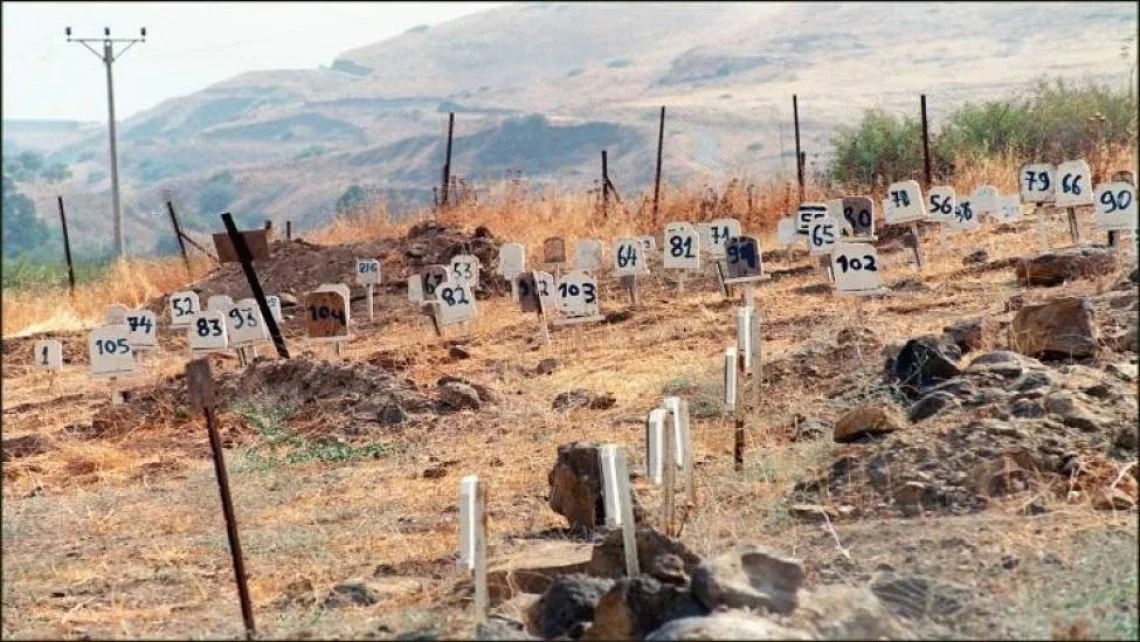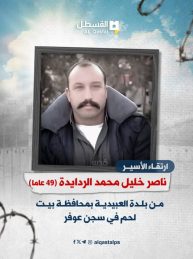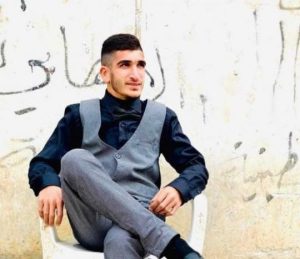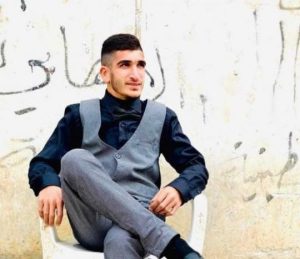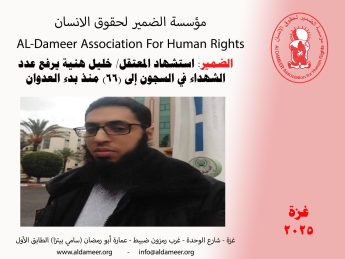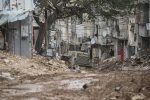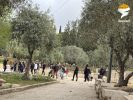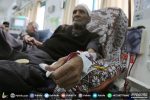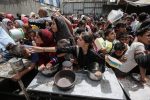RAMALLAH, (PIC)
The Israeli occupation not only arrests thousands of living Palestinians but also holds on to the bodies of martyrs, imprisoning them in what are known as the “Numbered Graves.”
The Israeli authorities detain the bodies of dozens of Palestinian and Arab martyrs who died while resisting the occupation or in prisons and detention centers. Many grieving families have been waiting to receive the remains of their loved ones for more than four decades.
The occupation forces deliberately bury these martyrs in secret cemeteries, surrounded by stones with no headstones, only a plaque bearing a number, hence the name “Numbered Graves.” Meanwhile, the bodies of many other martyrs are kept in refrigerators.
A systematic policy
The policy of holding the bodies of martyrs is one of the most heinous human, religious, legal, and moral crimes, violating all norms, laws, and international treaties that stipulate the right of the dead to be honored, buried according to their beliefs, and the right of their families to visit their graves.
Human rights organizations indicate that “Numbered Graves” date back to the founding of the Israeli state, but this practice intensified with the start of armed Palestinian resistance after 1967. The policy of holding Palestinian martyrs’ bodies reached its peak in 2015 when it was officially approved by the so-called “Israeli Supreme Court,” the highest judicial authority in the state, despite the absence of any local or international law permitting such actions.
According to Israeli media reports, these graves lack the minimum standards suitable for burying human beings. Some of them may have even been eroded due to soil displacement. The handling of the martyrs’ bodies buried in these graves is often degrading, with the martyrs frequently buried in sand and mud without a concrete barrier. In some cases, more than one martyr is buried in the same grave, and some graves contain both male and female martyrs.
Number of cemeteries
Although the exact number of Numbered Graves is unknown, recent Israeli and international media reports have revealed information about six such cemeteries:
The Numbered Cemetery near the “Jacob’s Daughters Bridge” in the “Amiad” military area at the intersection of the Palestinian, Syrian, and Lebanese borders. Some sources estimate that it contains around 500 graves, mostly of Palestinian and Lebanese martyrs who died in the 1982 war and afterward.
The Numbered Cemetery in the closed military area between Jericho and the Damia Bridge in the Jordan Valley. It is surrounded by a wall with an iron gate and a large Hebrew sign reading “Cemetery for the Enemy’s Victims.” It contains over 100 graves.
The “Shehita” Cemetery, located in Wadi al-Hamam village north of Tiberias, between Mount Arbel and the Sea of Galilee. Most of the bodies there are of martyrs from battles in the Jordan Valley between 1965 and 1975.
The “Ravidim” Cemetery in the Jordan Valley.
The “Manouha Nakouha” Cemetery in Beersheba.
Ashkelon Cemetery.
Reasons for holding the bodies
While Israeli authorities do not specify why they retain these bodies, many analysts and human rights activists suggest that this practice is used to exact revenge on the martyrs, deter others, serve as a bargaining chip, or even, according to some reports, to harvest their organs.
Organ harvesting
Issam Al-Arouri, the representative of the National Campaign to Recover Martyrs’ Bodies, revealed that Israeli authorities extract organs from the bodies of prisoner martyrs and sell them to medical centers specializing in this field. The Abu Kabir Forensic Institute also trades the organs of these martyrs in exchange for medical equipment.
On August 17, 2009, Israel launched a strong attack on the Swedish media after journalist Donald Boström published an article confirming that the Israeli state and its gangs engage in the trade of martyrs’ organs.
This claim has been further substantiated by images released in recent years showing martyrs’ bodies kept in refrigerators and returned missing some organs, with visible stitching suggesting incisions to remove organs. Some families have buried their sons without eyes or other organs but refrain from documenting these instances out of respect for the sanctity of the martyr, especially after long absences in refrigerators or Numbered Graves.
A negotiating card
The Israeli authorities refuse to provide any information on the number of detained bodies or their locations and deny issuing death certificates for the martyrs.
Although the occupation’s court ruled in 2017 that holding the bodies of martyrs is illegal, no decision has been made to release the bodies, citing flimsy excuses. The latest justification involved using the bodies as bargaining chips for Israeli soldiers held by Hamas in Gaza, even though the policy of holding martyrs’ bodies predates the formation of Hamas. This indicates that this policy is deeply rooted in Israel’s racist practices, exacting revenge on individuals even after their deaths.
Veteran martyr prisoners
The title “Dean of Prisoners” is given to the longest-serving living prisoner in Israeli jails, currently Nasser Barghouti, who has spent about 45 years in prison, interrupted only by a temporary release of 32 months during the “Wafa al-Ahrar” exchange deal.
Conversely, there are many martyrs who could be described as “Veteran Martyr Prisoners,” whose bodies have been held for many years, either still buried in “Numbered Graves” or kept in “Revenge Refrigerators.”
Martyr Anis Dawla
Anis Dawla was born in Qalqilya in 1944, joined the Palestinian revolution in 1966, and participated with his group in bombing the military governor’s headquarters in Nablus in late 1968. Anis engaged with the occupation forces to cover the retreat of his group members back to Jordan, was shot in the leg, and was captured after several hours of pursuit. He was sentenced to four life terms.
Anis endured severe torture, including beatings, sleep deprivation, and electric shocks, resulting in heart muscle weakness. Despite this, he participated in the July 1980 hunger strike that lasted 33 days. The prison authorities violently attacked the prisoners to force them to end their strike, resulting in the death of three prisoners, with Anis joining them a month later on August 31, 1980, at the age of 36.
His family filed a complaint with the Jerusalem Legal Aid Center to keep his case alive, and the center referred his file to the “Israeli Supreme Court,” which responded in a 2010 session by declaring that “the body is missing.” The case was closed in 2011, citing that all means to locate the body had been exhausted, making it one of the bodies whose existence Israel does not acknowledge.
Martyr Mashhour Al-Arouri
Mashhour Al-Arouri was born in Arura, Ramallah Governorate, in 1944 and joined the Palestinian resistance while studying in Lebanon. In 1976, he led a militant group belonging to the Democratic Front against an Israeli target in the Jordan Valley, where he was martyred at the age of 22.
Israel held Al-Arouri’s body in the Numbered Graves for 34 years before it was returned to his family in 2010 after medical tests confirmed his identity. Thousands of Palestinians attended his funeral from Ramallah Hospital to his hometown of Arura.
Al-Arouri is considered the first martyr whose body was retrieved by Palestinians after being hidden in the Numbered Graves.
Martyr Ali Al-Jaafari
Ali Al-Jaafari was born in Rafat village in 1946. His family migrated after the Nakba to Aqbat Jabr refugee camp in Jericho and later moved to live in Dheisheh refugee camp.
Ali joined the Palestinian revolution after 1967 and fought with occupation forces in Wadi Al-Qelt, Jericho, on January 8, 1968, where he was injured and captured while his comrades were martyred.
Al-Jaafari was sentenced to life imprisonment and came from a family of fighters—his brother Muhammad was martyred, with his remains still held in the Israeli military Numbered Graves, and his brother Ibrahim was martyred during the September events of 1970.
Ali was martyred in the Nafha prison hunger strike in July 1980. His body was held for 13 years in the Numbered Graves before being returned to his family in 1993, where he received a grand funeral in Bethlehem Governorate.
It is worth noting that the policy of detaining the bodies of martyrs by the Israeli occupation intensified after the most recent war on the Gaza Strip, as a means to use them as bargaining chips in the presence of Israeli prisoners held by the resistance.
It is a national and humanitarian duty for all active forces on the Palestinian scene to strive to recover the bodies of those martyrs detained by the occupation in cemeteries or refrigerators. This effort aims to enable their families to properly bury and honor them, recognizing the sacrifices they made.
The return of these bodies would allow families to finally hold dignified funerals, and it would restore a sense of closure to the loved ones who have been deprived of the right to mourn and honor their martyrs. It is also a fundamental step in upholding the values of respect for the deceased and human rights, which continue to be violated through this inhumane policy.
In this context, concerted efforts and international advocacy are essential. Highlighting these injustices on global platforms and urging international human rights organizations to pressure Israel to release the bodies are crucial actions. The goal is to ensure that these martyrs are given the respect they deserve in death, which is a basic human right that transcends political conflicts.

